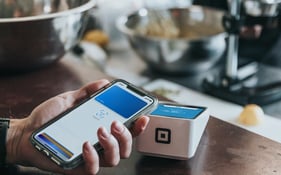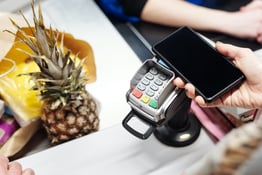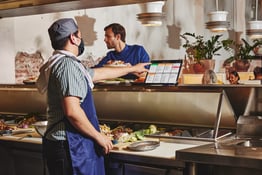Self-serve beer and wine taps started exploding in popularity back in 2018, with new restaurants popping up shaped entirely around the concept. And although the trend naturally came to a halt when the pandemic arrived, it’s now back on the rise, with many of the pour-your-own technology makers reporting significant increases in sales.
“We’re looking in this next year at triple-digit growth since last year,” says Darren Nicholson, vice president of sales and marketing of self-pour system iPourIt. “People are re-concepting and trying to differentiate their business, while trying to ensure they can sell and serve alcohol without costly labor and restraint issues.”
As customers begin returning to restaurants, and staffing shortages remain at an all-time high, self-serve tap systems bring an obvious appeal. But they aren’t for everyone.
Let’s take a look at how the systems generally work, and if they could be a good fit for your own restaurant.
How it works
There are a variety of self-serve tap systems available in the U.S. market from companies like iPourIt, PourMyBeer, Table Tap. And they all generally work off of a similar process.
Guests show up, check in with a host, and provide their ID and credit or debit card. At this point, guests receive a RFID (radio frequency identification) card or wristband, which gets them access to the “beer wall”. (It should be noted, many of these tap systems also offer beverages beyond beer, including wine, seltzer, kombucha, and even shots of hard liquor.)
The RFID card is scanned at the taps, allowing guests to pour as much or as little of any drink on the wall. “Our average pour size is 4.7 ounces per pour, which tells us it’s a sampling application,” says Nicholson. “People don’t feel comfortable asking the bartender for three tastes, but this gives guests the opportunity to create their own experience, on their own terms, on their own time.”
Pours are charged by the ounce. Laws regulating this technology vary from state to state, but generally customers are cut off after 32 ounces of beer, or the equivalent of two drinks. (Currently, self-pour is illegal in New Mexico, Utah, Oregon, Montana, Vermont, and West Virginia.) Operators can manually calibrate their tap system to deactivate RFID cards after a set number of ounces poured.
If a guest wants additional drinks once cut off, they’ll need to go to a staff member, who can re-up the RFID card if it’s deemed safe for the guest to continue drinking. Most operators put a cap at 64 ounces.
Many of the self-serve systems come with a digital screen located on top of taps, which may include information like the beverage name, type, brewer, description, ABV, IBU, price per ounce. A majority of the platforms also come with back-end software that allows operators to pull customer data and create reports.
Pros of self-serve taps
Similar to pumping your own gas at a gas station, self-pour tap systems enhance speed and convenience, while reducing reliance on human labor. And this is perhaps among the most obvious benefits right now, when restaurants are struggling to find enough people to tend bar.
“A self-pour system can take a lot of stress off an already lean staff, plus there’s a minimization of touch points,” says Tucker Criswell, sales executive at Table Tap. “It just takes an initial greeting when someone comes in, and from that point on, a customer doesn’t need to interact with staff if they don’t want to.”
That doesn’t mean a self-serve system needs to replace your most loyal bartenders. Like most automated technology, it can instead free up staff to partake in other meaningful roles, like customer education surrounding both the beer and the tap system itself.
Other potential benefits include a decrease in product waste and increase in profit.
“With a traditional bar, bartenders might give away free drinks. They might spill or over-pour drinks. And a bar owner can be wasting anywhere from 18- to 25-percent of each keg,” says Criswell. “With a self-pour system, every ounce is accounted for, and the only wastage is roughly three-percent, from the regular cleaning of the lines.”
With customers charged by the ounce, every single sample or tasting is monetized. And the convenience of being able to serve yourself whatever you want, whenever you want, can tempt people to try out higher-priced products. Plus, when customers don’t have to wait for a server to take their order, or stand in line to get a bartender’s attention, ordering more drinks becomes increasingly enticing. A fresh beer can be theirs within minutes.
Most self-pour systems allow operators to gather valuable customer data, too. This means, for example, operators can learn what their female demographic is drinking versus their male demographic, how much they’re spending, when they’re coming in, and customers’ average age. Other insights include which drinks are top-sellers, along with insights into weekly, monthly, and yearly sales. This can help determine what and how many beverages to stock. You can also use that data to run promos.
“A lot of our customers will do member Mondays. Or they’ll group members into categories, like IPA drinkers or seltzer drinkers, and use that for promotional discounts,” says Criswell, noting that Table Tap’s system allows operators to offer “member” RFID cards. Customers can load a prepaid balance onto the card, and the owner can then target “members” with discounts.
“Operators can start selling these cards before they even open and use them as interest-free loans,” says Criswell. “We’ve had customers recoup their investment within a month or less of opening.”
Then there’s the novelty factor. Self-pour systems are still relatively new and they can be a draw for potential new customers. Zac Johnston, co-owner of Bread and Butter in Covington, Georgia, says his 12-tap self-pour system has been a game changer since installed last year. The all-day cafe initially sold canned craft beer over the counter and has since seen roughly a 500% increase in beer sales since switching to self-pour, says Johnston.
“It’s definitely been worth the initial cost not just off of sales but as the traffic generator it’s become for our nights,” says Johnston. “We’re open till 9 p.m. during the weeknights and 10 p.m. on weekends, and now we’ve become this whole experience for customers, who want to bring their friends in and show them the system.”
Cons, and determining if it’s right for you
Self-serve taps do come with an upfront investment. And it’s not a nominal one. Typically, prices are calculated per tap, with the average ranging between $1,000 to $1,500 per tap. This means a 20-tap wall can set you back anywhere between $20,000 to $30,000.
“The average size system that we install is 36 taps, but we’ve installed systems between one tap and 88 taps,” says Nicholson. “The average cost for our technology is anywhere between $25,000 and $50,000.”
There’s also going to be an added construction cost if you need to retrofit your bar before installation.
“The retrofit market is probably the hardest – the operator has already created an operational efficiency in their business, so to make a wholesale change, it’s not only difficult for the operator but it’s difficult for the patron to understand,” says Nicholson. “So in most cases, these systems work best for new concepts, where beer is the focus.”
Table Tap says that while any draft system can be retrofitted, a majority of its sales are also with new construction.
But the payoff can be quick. Based on the data iPourIt collects, Nicholson says the average payback time for a larger taproom is around six months. And in the short-term, it can help cut staffing costs.
Yet, not every restaurant will recoup their costs so quickly, which makes it important to first evaluate your audience. If your lunch crowd is 60 to 70% of your business, a self-pour system may not be your best investment, unless you’re looking to increase your dinner crowd. Likewise, if you’re a spot focused largely on craft cocktails, you’re likely better off without a self-serve draft system.
“You can’t have beers on the wall and bartenders behind the bar, because the beer wall becomes a competitor to the bartender,” says Nicholson.
You should also consider your beverage versus food sales. A place where the emphasis is on beverage sales is destined to do better than a full-service restaurant where the experience is centered around sitting down for a full-course meal. “Self-pour is great for a very beer-centric place with a soft food menu because people can easily get up and interact with each other and travel back and forth to the wall,” says Criswell.
The future of self-pour taps
Given the nature of self-pour taps, we’re likely to see the trend take off in the fast-casual market. Here’s a setting where once you place an order, it’s unlikely you want to go back up to the counter. But with an RFID card, you can pour beer on demand, without waiting in line again.
Experts are predicting these systems to move into entertainment venues, like sporting arenas and concert venues, for similar reasons. “These are places where there’s always a concern for how quickly you can get back to your seat so you don’t miss anything, and self-serve solves that problem,” says Criswell.
The automatic cut-off feature makes them conducive to places like ax-throwing venues and bowling alleys, too.
The tap systems are also popping up in grocery stores, largely in the urban sector as a way for stores to differentiate themselves. And they’re increasingly going into luxury apartment complexes and hotels, with guests given an RFID card as an added amenity.
“Once the pandemic started, a lot of those markets became stagnant, but more and more people were staying home at their apartment complexes, and now about 50% of our business is with multi-family developers,” says Criswell. “They’ll put these in their apartment’s clubhouse or rooftop common area, and residents will get a certain amount of free beverages per day.
If you’re interested in learning more, your best bet is to reach out to a self-pour technology company. Most offer upfront consulting that can help further determine if the investment is right for you.
[Photos courtesy iPourIt]





